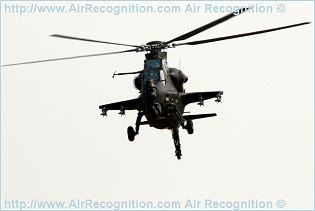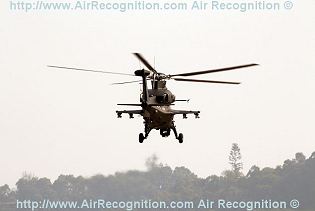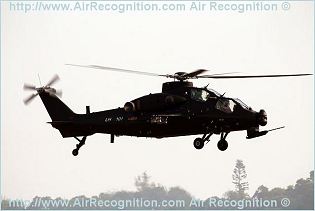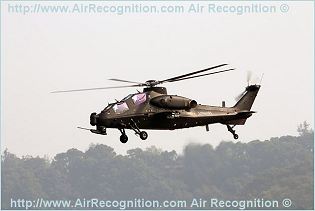| |
||||||||||||||||||||||
| a | ||||||||||||||||||||||
WZ-10
or Z-10 Attack helicopter |
||||||||||||||||||||||
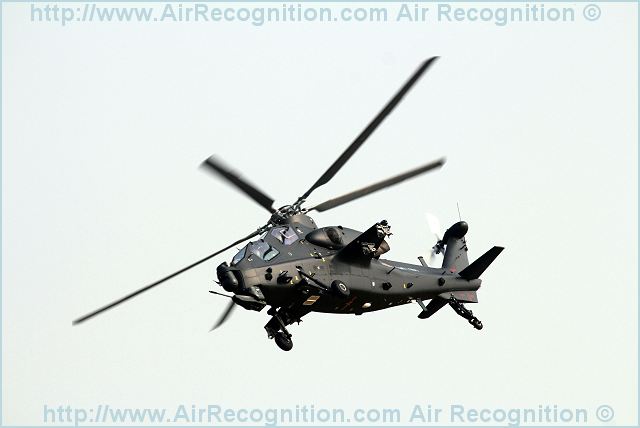 |
||||||||||||||||||||||
| |
||||||||||||||||||||||
The
Z-10 or WZ-10 is a Chinese-made attack helicopter designed and manufactured
by the Company Changhe Aircraft Industries Corporation (CAIC) of China.
The primary mission for the Z-10 is anti-tank missions, eliminating
the enemy ground fixed and mobile forces, and secondary air-to-air combat
missions. Development of the dedicated attack helicopter Z-10 began
in the mid-1990s at the 602 Institute and Changhe Aircraft Industry
Company (CHAIC) in Jingdezhen, Jiangxi Province. In May 2002, the WZ-10
tail rotor and some other components were tested on the ground by the
602nd Research Institute. In April 2003, a WZ-10 prototype completed
its maiden flight at Lumeng airfield. In the end of 2001, the final
test was completed on the full-scale rotary test platform, paving the
way for test flights. According to Chinese sources, the initial test
flights were concluded on December 17, 2003, whereas according to other
sources they were completed nine month earlier in March 2003. By 2004
3 more prototypes were built, for a total of 6, and a second stage of
test flights were concluded on December 15, 2004. A third stage of intensive
test flights followed, taking place during both day and night. By January
2006 weaponry and sensor tests, including firing of live ammunition,
were taking place. By 2012 the Z-10 helicopter was in production, and
initial batches were delivered to the People's Liberation Army of China
in 2009 and 2010. The Z-10 was unveiled for the first time to the public
during the AirShow China 2012 in Zhuhai. Several China's independently-developed
WZ-10 armed helicopters of an army aviation regiment under the Shenyang
Military Area Command (MAC) of the Chinese People's Liberation Army
(PLA) carried out air-to-ground missile firing tests in airspace of
south Liaoning province on November 12, 2012. Despite the extreme climate
conditions, the helicopters achieved a hundred percent hit rate. Characterized
by excellent flight performances and extreme low-altitude maneuverability,
the Z-10 helicopter can be equipped with multiple air-to-air and air-to-ground
precision-guided weapons, and possess the daytime and nighttime combat
capabilities. |
||||||||||||||||||||||
| Variants | ||||||||||||||||||||||
-
No variants |
||||||||||||||||||||||
| Technical Data | ||||||||||||||||||||||
| Design | ||||||||||||||||||||||
The Z-10 has a
conventional attack helicopter layout, with the pilot and weapons operator
seated in tandem, stepped cockpits. . The flight control of both aviators
serves to back each other up, and the pilot, who is also the team leader
of the aircrew, may override the gunner’s commands. The bottom
and sides of the cockpit are protected by composite armor, and so are
the engines and the fuel tank located in the middle of the fuselage.
Composite material is widely used in the WZ-10 but China faced difficulties
in this field, particularly in the area of survivability during crashes.
The fuselage has a sloped side to reduce its radar cross section (RCS),
and is slender and tapered to the rear, with fixed landing gear. The
tail boom tapers to the rear, with a high, swept-back fin with square
tip. The flats are unequally tapered with a square tip, while the belly
fin has the rear landing wheel attached. The tail rotor is mounted on
the right side. The WZ-10 has a non-conventional design that uses composite
and radar absorbent materials. The cabin's bulletproof glass may resist
7.62 millimeter ammunition and composite armor under the cabin resists
12.7 millimeters machine gun fires. The cabin is equipped to maximize
fire protection and the WZ-10 is also outfitted with ejection seats. |
||||||||||||||||||||||
| Propulsion | ||||||||||||||||||||||
The
Z-10 is powered by two Pratt & Whitney Canada PT6C-67C turboshaft
engines with Full Authority Digital Engine Control (FADEC). The engines
have a maximum continuous power of 1,531hp (1,142kw) each. The main
rotor is mounted in the midsection of the fuselage, consisted of a total
of five blades. The 4-blade tail rotor utilizes the similar to the tail
rotor of AH-64, with two pairs at unequal distance instead of 4 blades
at the equal distance, and one of the main purposes of such arrangement
was to reduce noise. The tail rotor blades are consisted of a total
of 11 layers of glass-reinforced plastic and composite material, enable
them to sustain direct bullet hits. |
||||||||||||||||||||||
| Avionics | ||||||||||||||||||||||
The
Z-10 helicopter is fitted with onboard inertial navigation system fully
integrated with GPS/GLONASS system, and provisions are made for future
upgrades to include Galileo (satellite navigation)/Beidou navigation
system when expanded capabilities of these systems become available.
The electronic warfare (EW) system of WZ-10 is the first Chinese EW
system that integrates the radar, radar warning receivers (RWR), laser
warning receivers (LWR), electronic support measures (ESM) and electronic
counter-measures (ECM) together. The system is designated YH-96, named
after the YH radar. YH-96 is claimed to have a high interception rate
of hostile signals, and in the fully automatic mode, it can automatically
analyze the threat and launch different decoys and jamming signals accordingly.
Alternatively, pilots can choose to launch decoys or jamming enemy sensors
themselves. . The identification friend or foe (IFF) system of WZ-10
is specially designed to work in an environment of heavy enemy jamming.
All internally mounted jamming and decoy launching systems are built
with the concept of modular design, so that they can be readily replaced
when newer technologies become available. An observation unit consisting
of a forward looking infrared (FLIR) and a low-light television is mounted
on a steerable platform at the nose of the helicopter. The electronic
countermeasures (ECM) suite consists of radar warning receiver (RWR),
laser warning receiver, infrared jammer and chaff / flare decoy dispenser.
In addition to the millimeter wave fire control radar and optronic FCS,
pilots of WZ-10 has another FCS, the helmet mounted sight (HMS). The
Z-10 helicopter can be equipped with the millimeter wave (MMW) fire-control
radar (FCR). MMW FCR is fully integrated with other subsystems of the
onboard electronic warfare system, such as radar warning receivers (RWR),
laser warning receivers (LWR), electronic support measures (ESM), and
electronic countermeasures (ECM), with the entire EW system on board
WZ-10 named after the radar. Final radar deployment configuration has
yet to be determined. |
||||||||||||||||||||||
| Accessories | ||||||||||||||||||||||
The
Z-10 helicopter is fitted with a ‘fly-by-wire‘ (FBW) control
system, and a modern glass cockpit with multifunctional display (MFD)
screens. The helicopter crew may also be equipped with a helmet-mounted
sight (HMS) for head-up display of information and weapon control. |
||||||||||||||||||||||
| Armament | ||||||||||||||||||||||
The Z-10 helicopter
is armed with a 23mm cannon mounted under the nose. Two stub wings provide
four stores stations for external ordinance. The main air-to-air missile
deployed by WZ-10 is TY-90, a missile specifically designed for use
by helicopters in aerial combat. The helicopter can carry up to eight
missiles under the stub wings for anti-armour role. Alternatively, the
helicopter can carry unguided rocket pods for ground attack, or TY-90
short-range air-to-air missiles for air combat. The turret is flexible
enough to incorporate configurations such as a single barrel machine
gun and an automatic grenade launcher with calibers ranging from 30
mm to 40 mm. WZ-10 can be armed with a wide variety of unguided rockets
ranging from 20 mm to 130 mm caliber. The largest rockets tested were
a type of 130 mm rocket that were carried on the hard-points just as
missiles are carried, while smaller caliber rockets were mounted in
conventional rocket pods. The most frequently used rockets are those
ranging from 57 mm to 90 mm and a total of 4 pods can be carried under
the stub wings, one under each hard-point. A family of 90 mm rackets
produced by the subsidiary of Norinco, the Harbin Jiancheng Group, was
first revealed at the 9th Zhuhai Airshow held in November 2012, designated
as Tianjian, or Tian Jian, meaning Sky Arrow. |
||||||||||||||||||||||
| Specifications | ||||||||||||||||||||||
|
||||||||||||||||||||||
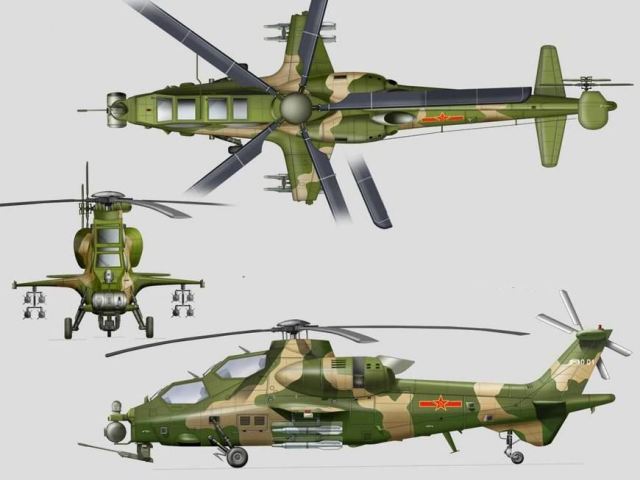 |
||||||||||||||||||||||
|
||||||||||||||||||||||
Z-10 WZ-10 attack fighting helicopter technical data sheet specifications intelligence description information identification pictures photos images video CAIC China Chinese PLA Air Force defence industry technology
- Posted On

